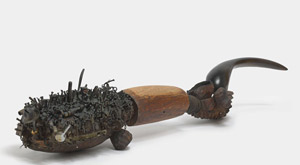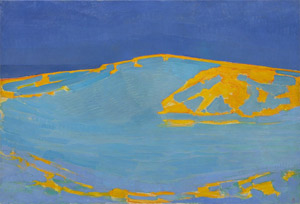7.23.25 — Multiplicity and Ambition
To wrap up from last time on Jack Whitten at MoMA, what, though, is the subject of his experiment? If he keeps changing, is there a constant to his art—or something he has been missing all along?
Either way, there is a lot to see. Whitten has the entire sixth floor, reserved for MoMA’s largest exhibitions. White latticed partitions for drawings bring them closer to materials, too and to the paintings. A huge central room holds more than one series all by itself.
The curator, Michelle Kuo, makes the case for an artist with many interests. Whitten found success early, with a 1994 show at the Whitney, and his influence extends to the broken tiles and mirrors of Rashid Johnson at the Guggenheim today.  His many directions mean nothing less than a greater ambition. Any painter who thinks that abstract art encompasses activism and music is already thinking big. And anyone who thinks that it translates into all of western art and a science experiment is thinking even bigger. Those deep black paintings see stars.
His many directions mean nothing less than a greater ambition. Any painter who thinks that abstract art encompasses activism and music is already thinking big. And anyone who thinks that it translates into all of western art and a science experiment is thinking even bigger. Those deep black paintings see stars.
Thinking big comports with Whitten’s one obvious constant, working big. It connects to his first loves in Abstract Expressionism and Mediterranean wall tiles. And work only grew. A triangle in honor of Malcolm X reaches to over feet in width, but the single largest is the tribute to 9/11, whose central image could be the Great Pyramid. Why? Puzzles like that abound, not always to the work’s advantage, but something big is going on.
A less obvious constant denies the whole question of his departures. With each new series, Whitten builds on and challenges past work. A late shift to ceramics recalls the painting for Invisible Man well before. Cuts recall a razor blade embedded in paint at its center. Ghostly images in black recall some of his earliest experiments, in abstract photography. They are passing through an unknown space, still finding their way.
They speak of the fate of invisible men, which points to one last constant. Those many histories from politics to music are his own as a New Yorker, a southerner, and a black. Whitten cultivates the tension between African American history and a history for all Americans. So does Whitten’s sculpture, inspired by folk and African art. It would be a new history, of grief and grievance, refuge and restitution, but such is the point. It would also be art.
Whitten has paid a price for so often changing his mind. I myself cannot always justify his departures or his returns. There are more luminous abstractions than his and more pointed tributes to the past. Not many, though, and they stand out at a time when diversity so often demands blind self-affirmation. Surely Whitten has better things to worry about than taking credit. After so many years, he can make his own totems.
Read more, now in a feature-length article on this site.
